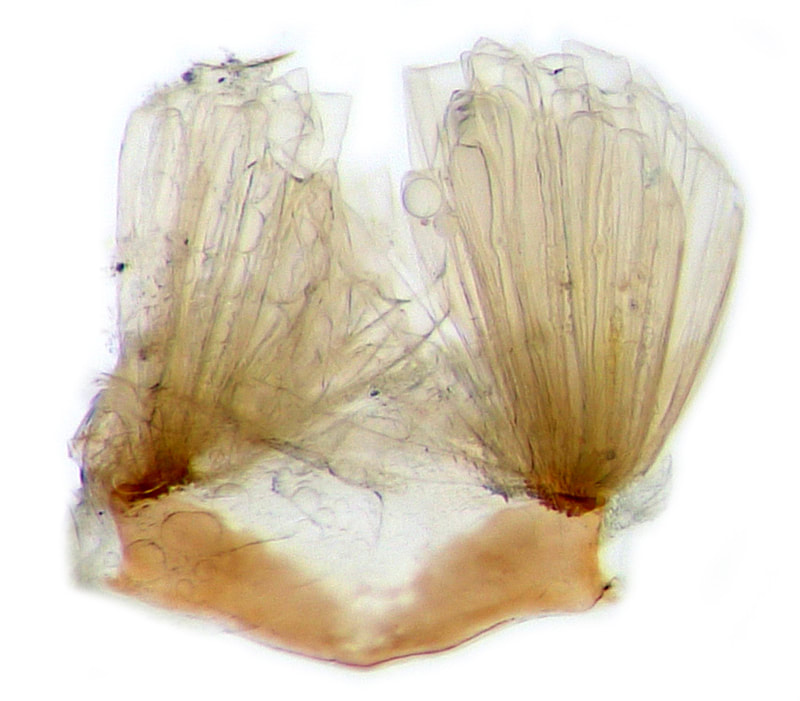62.039 Apomyelois bistriatella (Phoenix Knot-horn)
ws: 18-25mm; Jun-Jul; Daldinia concentrica (a fungus) growing on burnt gorse or young birch; NS-A - on burnt areas of heath in S.England from Surrey to Devon.
In Britain we have subspecies A.b.subcognata and not the nominate form.
In Britain we have subspecies A.b.subcognata and not the nominate form.
ID: Similar to Pyla fusca and Ortholepis betulae. All 3 are heathland species with similar flight periods.
The following features of A.bistriatella are said to distinguish it from P.fusca (expanded from Goater): 1. broader-winged; ratio of forewing length:width ~2.7 vs ~3.0. 2. first line whiter, particularly towards dorsum; in comparing web images it seems that A.bistriatella always shows a dorsal whitening of the first line and P.fusca sometimes does - so either this is not an absolute means of separating the species or some web images are incorrectly labelled. 3. first line curves onto dorsum; Goater doesn't make it clear how this is distinct from P.fusca and I am unconvinced that it is a useful distinguishing feature. 4. second line curves in middle towards termen, whereas it forms an irregular zigzag in P.fusca; again this is an unconvincing distinguishing feature when comparing web images of these two species. 5. hindwing more opalescent, versus translucent fuscous; comparative and unconvincing. 6. hindwing with more distinct border; comparative and unconvincing. 7. dark band in fringe of hindwing 1/3 width of fringe versus 1/5 in P.fusca; this should provide an absolute distinction, but since it is not visible on a live moth it would be sensible to confirm ID by genital dissection.
O.betulae can be more readily distinguished by the presence of a prominent scale-tuft just proximal to the first line.
Female genitalia: A.bistriatella has a distinct, discrete, rounded signum. It is not clear from images at dissection group whether P.fusca has a signum at all, but if it does it it is not distinct, discrete or rounded. The apophyses posteriores are ~equal in length to the apophyses anteriores in A.bistriatella while in P.fusca they are ~2x longer.
The following features of A.bistriatella are said to distinguish it from P.fusca (expanded from Goater): 1. broader-winged; ratio of forewing length:width ~2.7 vs ~3.0. 2. first line whiter, particularly towards dorsum; in comparing web images it seems that A.bistriatella always shows a dorsal whitening of the first line and P.fusca sometimes does - so either this is not an absolute means of separating the species or some web images are incorrectly labelled. 3. first line curves onto dorsum; Goater doesn't make it clear how this is distinct from P.fusca and I am unconvinced that it is a useful distinguishing feature. 4. second line curves in middle towards termen, whereas it forms an irregular zigzag in P.fusca; again this is an unconvincing distinguishing feature when comparing web images of these two species. 5. hindwing more opalescent, versus translucent fuscous; comparative and unconvincing. 6. hindwing with more distinct border; comparative and unconvincing. 7. dark band in fringe of hindwing 1/3 width of fringe versus 1/5 in P.fusca; this should provide an absolute distinction, but since it is not visible on a live moth it would be sensible to confirm ID by genital dissection.
O.betulae can be more readily distinguished by the presence of a prominent scale-tuft just proximal to the first line.
Female genitalia: A.bistriatella has a distinct, discrete, rounded signum. It is not clear from images at dissection group whether P.fusca has a signum at all, but if it does it it is not distinct, discrete or rounded. The apophyses posteriores are ~equal in length to the apophyses anteriores in A.bistriatella while in P.fusca they are ~2x longer.
§1 New Forest, Hampshire; 30/05/2010; female; fw 10.8mm
§2 Little Waltham, Essex; 09/05/2022; male; fw 9.5mm (specimen supplied by Andrew Raybould)
All images © Chris Lewis
§2 Little Waltham, Essex; 09/05/2022; male; fw 9.5mm (specimen supplied by Andrew Raybould)
All images © Chris Lewis
Page published 24/03/2012 (§1) | §2 added 07/08/2022












